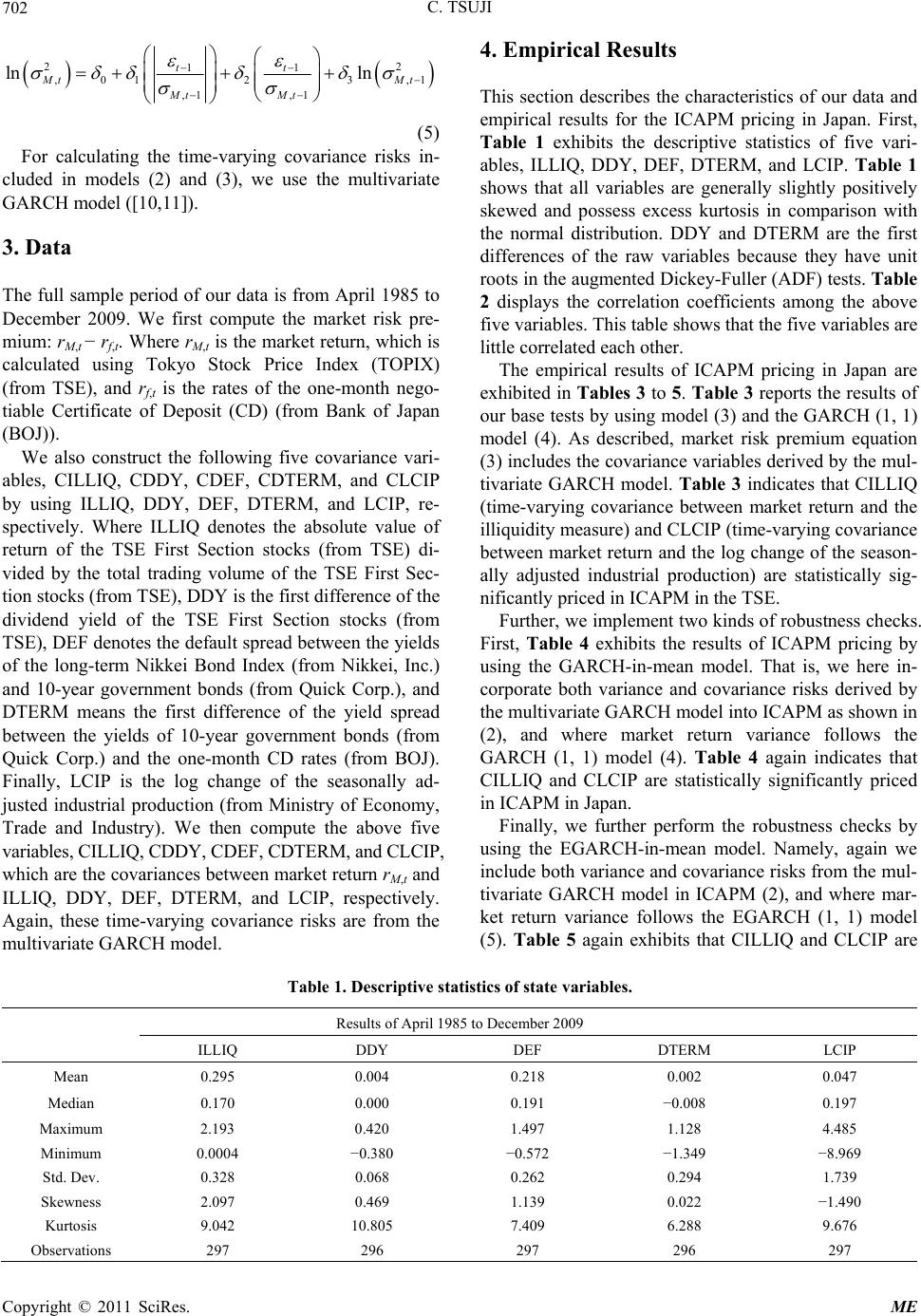
C. TSUJI
702
22
11
,0123 ,1
,1 ,1
ln ln
tt
Mt Mt
Mt Mt
(5)
For calculating the time-varying covariance risks in-
cluded in models (2) and (3), we use the multivariate
GARCH model ([10,11]).
3. Data
The full sample period of our data is from April 1985 to
December 2009. We first compute the market risk pre-
mium: rM,t − rf,t. Where rM,t is the market return, which is
calculated using Tokyo Stock Price Index (TOPIX)
(from TSE), and rf,t is the rates of the one-month nego-
tiable Certificate of Deposit (CD) (from Bank of Japan
(BOJ)).
We also construct the following five covariance vari-
ables, CILLIQ, CDDY, CDEF, CDTERM, and CLCIP
by using ILLIQ, DDY, DEF, DTERM, and LCIP, re-
spectively. Where ILLIQ denotes the absolute value of
return of the TSE First Section stocks (from TSE) di-
vided by the total trading volume of the TSE First Sec-
tion stocks (from TSE), DDY is the first difference of the
dividend yield of the TSE First Section stocks (from
TSE), DEF denotes the default spread between the yields
of the long-term Nikkei Bond Index (from Nikkei, Inc.)
and 10-year government bonds (from Quick Corp.), and
DTERM means the first difference of the yield spread
between the yields of 10-year government bonds (from
Quick Corp.) and the one-month CD rates (from BOJ).
Finally, LCIP is the log change of the seasonally ad-
justed industrial production (from Ministry of Economy,
Trade and Industry). We then compute the above five
variables, CILLIQ, CDDY, CDEF, CDTERM, and CLCIP,
which are the covariances between market return rM,t and
ILLIQ, DDY, DEF, DTERM, and LCIP, respectively.
Again, these time-varying covariance risks are from the
multivariate GARCH model.
4. Empirical Results
This section describes the characteristics of our data and
empirical results for the ICAPM pricing in Japan. First,
Table 1 exhibits the descriptive statistics of five vari-
ables, ILLIQ, DDY, DEF, DTERM, and LCIP. Table 1
shows that all variables are generally slightly positively
skewed and possess excess kurtosis in comparison with
the normal distribution. DDY and DTERM are the first
differences of the raw variables because they have unit
roots in the augmented Dickey-Fuller (ADF) tests. Table
2 displays the correlation coefficients among the above
five variables. This table shows that the five variables are
little correlated each other.
The empirical results of ICAPM pricing in Japan are
exhibited in Tables 3 to 5. Table 3 reports the results of
our base tests by using model (3) and the GARCH (1, 1)
model (4). As described, market risk premium equation
(3) includes the covariance variables derived by the mul-
tivariate GARCH model. Table 3 indicates that CILLIQ
(time-varying covariance between market return and the
illiquidity measure) and CLCIP (time-varying covariance
between market return and the log change of the season-
ally adjusted industrial production) are statistically sig-
nificantly priced in ICAPM in the TSE.
Further, we implement two kinds of robustness checks.
First, Table 4 exhibits the results of ICAPM pricing by
using the GARCH-in-mean model. That is, we here in-
corporate both variance and covariance risks derived by
the multivariate GARCH model into ICAPM as shown in
(2), and where market return variance follows the
GARCH (1, 1) model (4). Table 4 again indicates that
CILLIQ and CLCIP are statistically significantly priced
in ICAPM in Japan.
Finally, we further perform the robustness checks by
using the EGARCH-in-mean model. Namely, again we
include both variance and covariance risks from the mul-
tivariate GARCH model in ICAPM (2), and where mar-
ket return variance follows the EGARCH (1, 1) model
(5). Table 5 again exhibits that CILLIQ and CLCIP are
Table 1. Descriptive statistics of state variables.
Results of April 1985 to December 2009
ILLIQ DDY DEF DTERM LCIP
Mean 0.295 0.004 0.218 0.002 0.047
Median 0.170 0.000 0.191 −0.008 0.197
Maximum 2.193 0.420 1.497 1.128 4.485
Minimum 0.0004 −0.380 −0.572 −1.349 −8.969
Std. Dev. 0.328 0.068 0.262 0.294 1.739
Skewness 2.097 0.469 1.139 0.022 −1.490
Kurtosis 9.042 10.805 7.409 6.288 9.676
Observations 297 296 297 296 297
Copyright © 2011 SciRes. ME